Salesforce Subscription Management is a process that empowers businesses to manage all aspects of subscriptions, including order processing, billing, and renewals, directly within the Salesforce platform. By automating the back-end revenue tasks involved in selling and recognizing revenue from subscription products, Salesforce Subscription Management simplifies recurring revenue management and enhances the customer experience throughout the subscription lifecycle.
As a component of Salesforce Revenue Cloud, Salesforce Subscription Management integrates various touchpoints between businesses and their customers. It streamlines critical customer interactions throughout the entire customer lifecycle, encompassing billing, collections, and approvals, thereby facilitating the consolidation of self-service customer experiences. With Salesforce Subscription Management, organizations can establish scalable and streamlined processes for selling, invoicing, and revenue recognition related to subscription products. This capability fosters superior customer experiences across the entire purchasing journey, driving growth and facilitating business success.
Revenue Cloud Powering Subscription Management.
Revenue Cloud, introduced by Salesforce in 2020, combines CPQ, Billing, Partner Relationship Management, and B2B Commerce capabilities. It enables businesses to optimize revenue streams across sales channels, streamline processes, and drive growth. As part of the Salesforce Customer 360 Platform, Revenue Cloud enhances revenue management strategies, providing businesses with the tools they need to succeed in managing and maximizing their revenue.
What are the various aspects of Subscription in the revenue cloud?
In the context of Salesforce Revenue Cloud, a subscription encompasses several key aspects that are managed and supported by the platform:
- Subscription Creation: Revenue Cloud enables businesses to create and define various subscription plans and offerings tailored to their customers’ needs. This includes setting pricing, terms, and conditions for different subscription tiers or packages.
- Order Management: The platform handles the end-to-end order management process for subscriptions. This includes capturing and processing subscription orders, managing order changes and amendments, and ensuring accurate fulfilment and delivery of subscription services or products.
- Billing and Invoicing: Revenue Cloud automates the billing and invoicing processes associated with subscriptions. It generates invoices, calculates recurring charges, applies discounts or promotions, and handles any proration or adjustments required based on subscription changes or upgrades.
- Revenue Recognition: Salesforce Revenue Cloud helps businesses accurately recognize revenue from subscriptions based on accounting standards and rules. It automates revenue recognition processes, ensuring compliance and providing visibility into revenue streams and performance.
- Subscription Renewals and Expirations: The platform tracks subscription renewal dates, sends reminders, and facilitates the renewal process. It also manages subscription expirations, allowing businesses to proactively engage with customers for renewal or upsell opportunities.
- Customer Self-Service: Revenue Cloud provides self-service capabilities for customers to manage their subscriptions. This includes features like account management, subscription upgrades or downgrades, payment options, and access to billing and usage information.
Overall, Salesforce Revenue Cloud offers comprehensive support for subscription management, covering aspects from creation and order management to billing, revenue recognition, and customer self-service. It aims to streamline and optimize the entire subscription lifecycle for businesses, enabling them to drive revenue growth and deliver an enhanced customer experience.
How to start using Subscription Management?
Required Editions and User Permissions:
- Before getting started with Subscription Management in Salesforce, it is important to ensure that you have the required editions and user permissions.
- Subscription Management is available in Lightning Experience.
- It is supported in Enterprise, Unlimited, and Developer Editions with a Subscription Management license in Sales Cloud and Service Cloud.
Accessing Subscription Management:
- Inside setup menu locate “General setting” Using Quick Find search bar.
- Select the General Settings inside “Subscription Management” option to proceed.
- This section provides various customization options to tailor your subscription management experience.

Enabling New Order Save Behaviour:
- Find Update in Release and activate the “Enable New Order Save Behaviour” option.
- To use Subscription Management, first turn on New Order Save Behaviour to allow rules, triggers, and flows to run whenever an order product update causes a change to the parent order.
- A close-up of a document
- Description automatically generated with medium confidence

User Permissions Needed:
To turn on Subscription Management, ensure users have the “Customize Application” user permission assigned to them.
Key Features inside Subscription management
- Estimated Tax Inclusion in Quotes: Enhance quote accuracy by incorporating estimated taxes for subscription products, providing customers with more transparent pricing information.
- Automatic Creation of Payment Schedules and Items: Streamline financial transactions by setting up default payment schedule policies that automatically generate payment schedules and items, simplifying invoice processing.
- Automated Conversion of Negative Invoice Lines to Credit Memos: Effortlessly handle negative invoice lines by automatically converting them into credit memos upon invoice posting, ensuring accurate accounting, and streamlined credit processes.
- Automated Refunds and Balance Settlement: Simplify order changes or cancellations by automatically issuing refunds and applying credit memos to settle any remaining invoice balances, improving efficiency and customer satisfaction.
- Suppression of Subscription Management Billing Functionality: Optimize subscription management by suppressing the creation of billing schedules, reducing the need for additional order and order product fields, and streamlining overall processes.
Benefits of Subscription Management
Salesforce Subscription Management helps businesses in many ways. Here are some benefits of Salesforce Subscription Management:
- Enables customers to effortlessly acquire, enhance, extend, and make payments for products via self-service channels like e-commerce platforms, mobile applications, and various websites.
- Improves the subscription business model.
- Assists in streamlining vital interactions with customers throughout their entire journey, encompassing billing, collections, and approvals through automation.
- Unifies self-service customer experiences.
- Puts businesses in total control of the billing process.
Leave A Comment